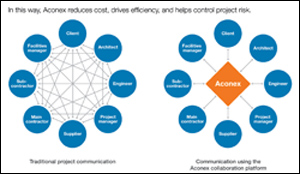 — Ashok Kumar, Regional Director – ASEAN & India, Aconex
— Ashok Kumar, Regional Director – ASEAN & India, Aconex
Indian developers want first world practices, designs and methodologies and we see more global architects and consultants participating in Indian projects, Ashok Kumar of Aconex, the world’s largest provider of project collaboration solutions to the construction and engineering industries, tells Sandeep Menezes in an interview. This, he believe, is a welcome trend and is just the beginning.
What are the communication challenges in large projects?
Construction and engineering projects are becoming more globalised wherein multiple organisations from across different geographies and disciplines come together to execute a project. For example, for an airport project in India, there were over 80 different organisations working on the project with over half of them located outside of India. Also, building disciplines are getting more specialised like architecture, M&E, civil and structural, landscaping, LEED consultants etc. wherein no one company can provide all or most of these services, thus adding to coordination challenges in any project. Bigger the project, bigger are such challenges.
Do you agree that about 66 per cent of construction problems are caused by poor information management or team communication?
That is right. Industry research shows that 66 per cent of construction problems are due to inadequate information and poor communication leading to disputes, delays and quality issues thereby making project information management quite central to improving margin and reducing risk in executing construction and engineering projects.
Those with most risks are the asset owners/and developers and general contractors/main Contractors delivering those projects as lot of disconnects often happen outside of their organisations over which they have little control or early visibility.
 How should project managers effectively maintain visibility over the flow of information and communication between parties?
How should project managers effectively maintain visibility over the flow of information and communication between parties?
Project collaboration and document management is the way to go. Effective collaboration between participants is at the core of project success. Best practice information management underpins collaboration and can help address some of the key challenges they face. Creating a single point of reference, accountability for decisions and transactions, controlled document distribution and revision, managing formal project correspondence between dispersed teams and implementing project wide processes and approval mechanism are some of the measures that will add to the success of the project.
With projects involving enormous volume of data, how can it be made easier to produce and exchange information?
Very true. As projects generate a large volume of data, the inefficiencies of relying on traditional information management tools, such as paper documents, spreadsheets and individual email accounts, have driven the widespread adoption of online collaboration systems.
Collaborative information management is the key. It enables businesses to manage their information resources in a consistent manner, to support service delivery and to fulfil their scope of works. Web-based collaboration solutions enable project participants to manage their project information, including drawings, documents and correspondence, online through one secure central platform. This allows authorised persons to access, distribute, track and archive their information electronically, from any location and at any time.
Such a collaborative tool can facilitate every stage of the project. During the early development phase, the developer can communicate in a structured way with key consultants such as the architect, engineers, project manager and quantity surveyor. If the initial development work has been carried out on a collaboration solution, the preliminary documents are then available in one place, ready to distribute to the wider consultant team for detailed design. Later in the process, online collaboration can facilitate the compilation and management of the head contractor tender documentation package, and handle responses. With all the documentation already in the system, the successful head contractor can then compile and manage sub-contract tender packages in the same way.
As the project moves into the building phase, the same system is used to manage RFIs, the submission and approval of shop drawings, processing of claims and payments, defect management, and so on. At the end of the project, it is used to submit as-built drawings and manuals, and to manage essential services certification. The system controls the handover of as-built documents to the client and can be retained for ongoing management of information related to the facility.
Importantly, the procedures for communicating and managing project information using a collaboration system mirror existing standard industry practices; but processes are streamlined by being undertaken electronically and each stage can be tracked
 What have been the commonly-used tools for managing project communication in India?Tell us about the limitations of such tools.
What have been the commonly-used tools for managing project communication in India?Tell us about the limitations of such tools.
Currently, it is quite fragmented. Most of the companies rely on their internal systems which may be a combination of paper drawings, spreadsheets and email accounts. Some have moved to setting up FTP servers to share documents and files with external organisations. A few have set up bespoke Sharepoint portals built around processes mapped to their individual organisations, more like generic enterprise content management systems. None of these tools are really project wide such that all organisations on the project are able to use them. This leads to each organisation having their own systems and often with duplicate information and different version of drawings and documentation. Need of the hour is really to have one single platform with one agreed processes across all organisations involved in the project.
The uptake of online collaboration systems in India is much lower than the global market.
I would say that in the last couple of years, there is an increasing trend to use best practices from around the world for projects in India. Indian developers want first world practices, designs and methodologies to differentiate their offerings. We see more global architects and consultants participating in Indian projects. This, I believe, is a welcome trend and is just the beginning. Online collaboration solution like Aconex which was driven mainly by foreign consultants, is being adopted by local architects, developers and consultants as well. This trend will accelerate in next couple of years and we believe more and more projects will use Aconex.
Currently, less than 10 per cent of projects in India use collaboration systems. Tell us about the future growth of the market in India and the role that Aconex intends to play.
We expect adoption of Aconex to grow substantially in the next three to five years. Today, we are the standard for project collaboration in India and we expect this trend to continue on a wider basis with local developers leveraging the benefits we bring to the project. To this end, we have grown our operations substantially, with our global Business Support Centre located in Bangalore and also with sales and support offices in Mumbai and Delhi. India today is our second largest office location globally.











